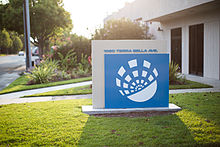SkySat
| Terra Bella logo | |
 | |
| Company type | Subsidiary |
|---|---|
| Industry | Information Services |
| Founded | January 2009 |
| Headquarters | Mountain View, California |
Area served | Worldwide |
| Services | Satellite imagery, video, and analytics of Earth |
| Owner | Alphabet Inc. |
Number of employees | 125 |
| Website | terrabella |
Terra Bella (formerly Skybox Imaging) is a Google subsidiary providing commercial high-resolution Earth observation satellite imagery, high-definition video and analytics services. The Mountain View, California-based company was founded in 2009 by Dan Berkenstock, Julian Mann, John Fenwick, and Ching-Yu Hu.[1] Terra Bella was named no. 1 on Inc. magazine's 25 Most Audacious Companies in 2014.[2]
Overview
The resolution of its SkySat satellite imagery and videos is high enough to observe objects that impact the global economy like terrain, cars and shipping containers. Terra Bella says its satellites can capture video clips lasting up to 90 seconds at 30 frames per second.[3] The high-definition satellite video from SkySat satellites “could help us understand our world better by analyzing movement of goods and people, providing visual data about supply chains, shipping, industrial plant activity, and even humanitarian relief efforts.”[3]
The company's goal is to be able to provide high-resolution satellite imagery of any place on Earth multiple times a day.[4] Terra Bella has plans to “change the nature” of the satellite industry by building satellites with “off-the-shelf” electronics that cost under $50 million.[5]
Satellite constellation
The SkySat satellites are based on the CubeSat concept with optimized design using inexpensive automotive grade electronics,[6] as well as fast commercially available processors. The cameras use two-dimensional imaging sensors.
Timeline
By April 2012 Terra Bella had raised a total of US$91 million of private capital from Khosla Ventures, Bessemer Venture Partners, Canaan Partners and Norwest Venture Partners.[4]
On November 21, 2013, Terra Bella’s first satellite, SkySat-1, launched on the Dnepr rocket from Yasny, Russia.[7] On July 8, 2014, Skybox's second satellite, SkySat-2, launched on a Soyuz-2/Fregat rocket from Baikonur, Kazakhstan.[8] The company plans to eventually launch a fleet of 24 satellites.[9]
On December 11, 2013, the first images captured by the SkySat-1 satellite, of Perth, Abu Dhabi, and the coast of Somalia, were released.[10] On July 10, 2014, the first images captured by SkySat-2 were released within 48 hours of launch.[11]
On February 10, 2014, SSL announced that Terra Bella had awarded SSL a contract to build 13 satellites based on a Terra Bella design.[12] Skysat 3 was launched in June 2015 by ISRO on PSLV XL with contract for four more satellites to launch. [13]Arianespace will launch several Skybox Imaging satellites in 2016 and 2017, using the Vega small launch vehicle.[14]
On June 10, 2014, Terra Bella announced that it had entered into an agreement to be acquired by Google for US$500 million.[15][16] The acquisition was completed on August 1, 2014.[16][17]
On March 8, 2016, Google announced that Skybox Imaging had changed its name to "Terra Bella", to indicate its focus on image analytics.[18] The new name was partially based on the Terra Bella Ave. in Mountain View, California, where the company's headquarters are located.[19]
References
- ^ Perry, Tekla S. (1 May 2013). "Start-up Profile: Skybox Imaging". IEEE Spectrum. Retrieved 12 May 2014.
- ^ "25 Companies That Are Changing the World". Inc. 23 April 2014. Retrieved 12 May 2014.
- ^ a b Wogan, David (30 December 2013). "High-definition video from space is available for purchase. Finally". Scientific American. Retrieved 12 May 2014.
- ^ a b Burns, Matt (17 April 2012). "Skybox Imaging Raises $70M To Launch Two High-Res Imaging Microsatellites". TechCrunch. Retrieved 12 May 2014.
- ^ Truong, Alice (11 December 2013). "Proof That Cheaper Satellites Still Can Take Incredibly Detailed Photos of Earth". Fast Company. Retrieved 12 May 2014.
- ^ http://www.skybox.com/technology#satellite-sensors
- ^ Clark, Stephen. "Silo-launched Dnepr rocket delivers 32 satellites to space". Website. Spaceflight Now. Retrieved 12 May 2014.
- ^ Hearn, Mark. "Skybox Imaging successfully launches its SkySat-2 Earth observation satellite". Website. 9to5Google. Retrieved 8 July 2014.
- ^ Eisenberg, Anne (10 August 2013). "Microsatellites: What Big Eyes They Have". The New York Times. Retrieved 12 May 2014.
- ^ Truong, Alice. "Proof That Cheaper Satellites Still Can Take Incredibly Detailed Photos Of Earth". Website. Fast Company. Retrieved 11 December 2013.
- ^ Henry, Caleb. "Skybox Imaging Releases First Images from SkySat 2". Website. Satellite Today. Retrieved 11 July 2014.
- ^ http://sslmda.com/html/pressreleases/pr20140210.html
- ^ "VIKRAM SARABHAI SPACE CENTRE - PSLV". ISRO. Retrieved 18 April 2015.
- ^ http://spacenews.com/vega-to-launch-skybox-satellites/
- ^ http://investor.google.com/releases/2014/0609.html
- ^ a b "Skybox Imaging + Google". 8 June 2014. Retrieved 29 June 2016.
- ^ Henry, Caleb (2014-08-05). "Google Closes Skybox Imaging Purchase". Via Satellite. Retrieved 2014-08-10.
- ^ Lardinois, Frederic (8 March 2016). "Google renames its satellite startup, Skybox Imaging, to Terra Bella and adds focus on image analysis". TechCrunch. AOL Inc. Retrieved 8 March 2016.
- ^ Protalinski, Emil (8 March 2016). "Google rebrands Skybox as Terra Bella, will launch 'more than a dozen satellites' over the next few years". VentureBeat. Retrieved 8 March 2016.
